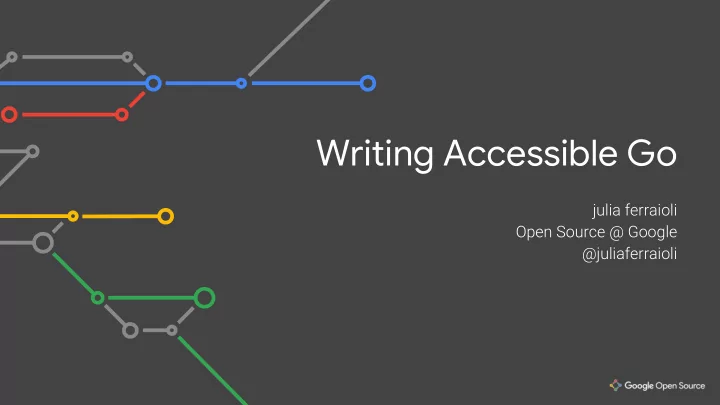

Writing Accessible Go julia ferraioli Open Source @ Google @juliaferraioli
Transcript: http://bit.ly/accessible-go-transcript
Hi, I’m julia Writer of code for people who write open source code Gopher for a few years Frequently understatedly described as “stubborn” AKA “stubborn AF” @juliaferraioli
Vision-impaired off-and-on for the past two years
GIF by Jim Haseloff: http://bit.ly/2uCJYCj
Uhhh...
Intermittent failures are the WORST @juliaferraioli
I was/am (intermittently) disabled
“[Disability] is a complex phenomenon, reflecting the interaction between features of a person’s body and features of the society in which [they live].” - World Health Organization
Think about your tool set CC-by-2.0 image of a workbench by Sam Beebe: https://flic.kr/p/bU9r8t
Demo
We make products accessible, but not the processes by which they are built
Accessible tooling is not enough CC-by-2.0 image of drill bits by massmatt: https://flic.kr/p/Vw398F
Some hard-earned lessons in writing accessible code
Group code blocks logically a, b := Vector{1, 2, 3}, Vector{4, 5, 6} a, b, _ = swap(a, b) c := Vector{7, 8, 9} total, _ := add([]Vector{a, b, c}...) OK @juliaferraioli
Group code blocks logically a, b, c := Vector{1, 2, 3}, Vector{4, 5,\ 6}, Vector{7, 8, 9} a, b, _ = swap(a, b) total, _ := add([]Vector{a, b, c}...) NOT RECOMMENDED @juliaferraioli
Group code blocks logically a, b := Vector{1, 2, 3}, Vector{4, 5, 6} a, b, _ = swap(a, b) c := Vector{7, 8, 9} total, _ := add([]Vector{a, b, c}...) ● Keep your variables close to where they are used ● Same with interfaces, struct, type declaration @juliaferraioli
Keep names short var a, b Vector OK var vectorA, vectorB Vector NOT RECOMMENDED ● Fast to listen to ● Easier to navigate around ● Less effort to type @juliaferraioli
Make names meaningful var total, scaled Vector OK var tVec, sVec Vector NOT RECOMMENDED ● Meaningful names reduce cognitive load ● A light form of self-documenting code ● Reduces the amount of jumping around in the codebase @juliaferraioli
Use pronounceable names var total Vector OK func add(...) OK var tVec Vector NOT RECOMMENDED func addAllVecs(...) NOT RECOMMENDED ● Screenreaders can read them ● Takes less time than pronouncing a string of letters @juliaferraioli
Use new lines intentionally a, b := Vector{1, 2, 3}, Vector{4, 5, 6} a, b, _ = swap(a, b) c := Vector{7, 8, 9} total, _ := add([]Vector{a, b, c}...) ● New lines are your code’s paragraph breaks ● Don’t use them too much or too little @juliaferraioli
Be consistent ● Pick styles early ● Update your code [Add image here] ● Keep enforcing them @juliaferraioli CC-by-2.0 image of bricks by Joost Markerink: https://flic.kr/p/CzNd9S
Why do any of this?
Disability can be [Add image here] invisible @juliaferraioli CC image of doorways by MaZzuk: https://flic.kr/p/2jTdEk
Disability isn’t [Add image here] binary @juliaferraioli CC image of lightswitch by Paul Comstock: https://flic.kr/p/3g9Y74
Accessibility is for [Add image here] everyone @juliaferraioli Image of the Earth from SPAAAAACE
The curb cut effect Public domain image of a curb cut from the sidewalk to the street
Curb cut effect Built for a single Serves the needs of population or purpose others as well @juliaferraioli
Curb cuts for your code ● Improved maintenance ● Better onboarding [Add image here] ● More inclusive environment @juliaferraioli CC image of a robot with backpack by Morgan: https://flic.kr/p/6UCCUx
Writing accessible Go ✓ Organize your code logically ✓ Use pronounceable names ✓ Be consistent @juliaferraioli
More info ● Transcript of this talk: http://bit.ly/accessible-go-transcript ● Python Code Style for Blind Programmers: http://bit.ly/2uBWHoY ● Emacspeak: http://bit.ly/emacspeak ● Tools of a Blind Programmer: http://bit.ly/tools-of-a-blind-programmer ● Curb cuts: http://bit.ly/99-curb-cuts @juliaferraioli
Thank you! julia ferraioli jrf@google.com twitter.com/juliaferraioli
You’ve gone too far! CC-by-2.0 image of an octopus by Web Betty: https://flic.kr/p/EBcxjV
Recommend
More recommend